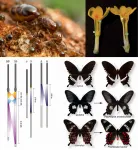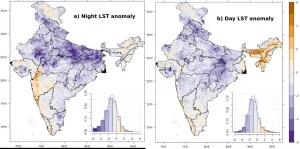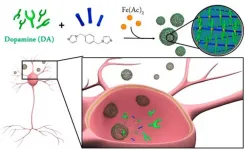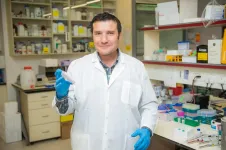The evolutionary fates of supergenes unmasked
2021-06-01
(Press-News.org) While the term "supergene" may bring to mind the genetic hocus-pocus of Peter Parker's transformation into Spiderman, supergenes are actually fairly common phenomena in the realm of biology. A supergene refers to a genomic region containing multiple genes or genetic elements that are tightly linked, allowing genetic variants across the region to be co-inherited. Supergenes may arise when there is a clear benefit to inheriting specific combinations of biological traits together. Perhaps the most well-known examples of supergenes are sex chromosomes, which allow traits that are beneficial to the reproductive success of one sex to be co-inherited. In humans, this explains the prevalence of male-specific genes on the Y chromosome. While the concept of supergenes arose nearly a century ago, until recently, the study of their origin, evolution, and eventual fate was largely theoretical. Now, however, thanks to advances in genomic sequencing and computational biology, scientists can put those theories to the test with real-world data. In a recent review published in Genome Biology and Evolution titled " The genomic architecture and evolutionary fates of supergenes ", Associate Professor Tanja Slotte and her colleagues at Stockholm University in Sweden discuss new findings in the field of supergene evolution and reveal how the genomic architecture of a supergene is inextricably tied to its evolutionary fate.
"There is a rich history in evolutionary biology when it comes to the study of supergenes," says Slotte. "What I like about this topic is that there are theoretical models of supergene evolution to draw on, and at the same time, we can now thoroughly test those expectations empirically using genomic data or explore the expected effects of different genomic architectures using simulations." In particular, these new approaches can be used to assess the validity of some of the more well-established theories about supergenes.
Classical models posit that supergenes arise following the establishment of mutations at a minimum of two sites, followed by sequential accumulation of additional mutations. Selection for specific combinations of variants acts to suppress recombination, thus strengthening the linkage between mutations. This suppression of recombination often occurs through inversions, in which a genomic region is flipped on the chromosome, effectively inhibiting recombination. Because recombination enables the removal of deleterious mutations, however, once it has stopped, the supergene may degenerate through the accumulation of single-nucleotide mutations, as well as insertions, deletions, and the replication of transposable elements. Notably, this last characteristic of supergenes has made them particularly difficult to study until now. Notes Slotte, "This is a very good time for studying supergene evolution. Thanks to long-read sequencing and improved bioinformatic methods we can now obtain high-quality assemblies, including well assembled supergenic regions. This is not a trivial task, as non-recombining regions are often highly repetitive and therefore difficult to assemble."
In their review, Slotte and her collaborators discuss the ways in which new sequence data has challenged some classical supergene models. "One aspect that I find really fascinating is how empirical genomic studies are still yielding surprises when it comes to the origin and the genetic architecture of classic supergenes," says Slotte. An example of this is the case of the supergene governing wing pattern mimicry in the butterfly Heliconius numata. H. numata exhibits Müllerian mimicry, displaying one of seven different wing patterns, each of which mimics a different local species of the poisonous butterfly Melinaea, thus reinforcing their protection against predators. Recent data show that, rather than arising via the classical model of sequential mutation followed by inversion, the inverted chromosomal arrangement in H. numata arose via introgression from another Heliconius species. According to Slotte, this is a scenario that should be further explored using simulations and modeling.
Another surprise stemmed from recent studies of the S-locus supergene governing heterostyly in primroses. Heterostyly is a common plant adaptation resulting in the presence of two distinct flower morphs (S- and L-morphs) within a species. In each morph, the male and female reproductive organs in the flower are arranged in such a way that it is difficult for an individual plant to fertilize itself, limiting inbreeding and promoting outcrossing. Classical theories posited that S-morph flowers were heterozygotes (carrying two different versions of the S-locus supergene), while L-morph flowers were homozygotes (carrying two identical versions). Instead, new evidence reveals that primroses with S-morph flowers harbor an insertion spanning five genes that is absent from L-morph primroses, making S-morph plants hemizygotes (carrying a single copy of the S-locus).
In their paper, Slotte and colleagues further take advantage of advances in bioinformatics and computational biology to reveal new insights into supergene evolution. "When it comes to delineating expected patterns of evolution," says Slotte, "we benefit enormously from new efficient and flexible simulation software." Indeed, based on the new findings regarding the primrose S-locus supergene, Slotte and her co-authors used SLiM, a forward simulation program, to compare two hypothetical S-locus systems: the classic inversion model and the new model, in which an insertion leads to a supergene that is hemizygous in S-morphs. Their results revealed that the inversion accumulated more than six times more deleterious mutations than the hemizygous region and that each of these mutations on average had more deleterious effects, demonstrating that the specific genomic architecture of a supergene has a powerful effect on its ultimate degeneration and evolutionary fate.
In addition to the insights revealed by new sequence data and simulations, scientists have an unprecedented opportunity to study supergene functionality thanks to new genetic and molecular biology tools. According to Slotte, "Elucidating the function of genes located in supergenes has long been difficult, as by definition it is challenging to fine-map anything in a non-recombining region, but with the help of new genome editing techniques, this is now becoming increasingly feasible." In particular, Slotte hopes to use a combination of these approaches to study a new supergene target: "I recently got a great opportunity to bring this work to a new level through a Starting Grant from the European Research Council to study the supergene that governs heterostyly in wild flaxseed species (Linum). This work is now ongoing, and I am very excited about using this system to study supergene and plant mating system evolution."
INFORMATION:
[Attachments] See images for this press release:

ELSE PRESS RELEASES FROM THIS DATE:
2021-06-01
(Boston)--Only a small subset of people who get a lung infection go on to become very sick yet who will become severely ill or why is unclear. This is now widely recognized in the context of COVID-19, where most people have mild or no illness while others with the same infection become extremely sick or even die.
Researchers now have discovered that after recovering from a respiratory infection, new cells get deposited in lung tissue, persist there and then become antibody secreting cells very quickly if the lungs later get re-infected by something similar.
"It is increasingly clear that our lungs contain their own specialized immune system, different from the immune system throughout the rest of the body," explained corresponding ...
2021-06-01
In some environments there is no way for a seed to know for sure when the best time to germinate is.
In spring, cues like light, temperature and water may suggest to seeds that conditions are optimal for germination, but a week later an unpredictable drought or frost could kill the emerging seedlings.
So how does a plant make sure that all of its offspring are not killed at once by an ill-timed environmental stress following germination?
There is evidence that some plant species produce seeds that germinate at different times to hedge their bets against this risk. Many species produce seeds that can enter a dormant state and exist in the soil for several years and some also produce seeds that germinate at different ...
2021-06-01
Research by scientists from University of Southampton (UK) and the Central University of Jharkhand (India) and has shown the first COVID-19 lockdown in India led to an improvement in air quality and a reduction in land surface temperature in major urban areas across the country.
The study found that travel and work restrictions imposed early in the pandemic resulted in a significant environmental improvement, due to an abrupt reduction in industrial activities and a major decrease in the use of land and air transport.
The international team used data from a range of Earth Observation sensors, including those from the European Space Agency's Sentinel-5p and NASA's MODIS sensors, to measure changes in surface temperature and atmospheric ...
2021-06-01
Efforts to contain the novel coronavirus have caused lockdowns and school closures around the world. These efforts and policies have unfortunately cut off many children from valuable resources such as the opportunity for exercise, access to clean water and food, learning, and socialization. Therefore, the effects on mental health and behavior may be found not just in adults but children. However, studies published thus far have been limited to elucidating the mood of middle school and high school students and the conditions for which mood problems occur ...
2021-06-01
Drinking straws are single use plastic products which will be subjected to a Europe-wide sales ban from 2021 onwards. This is stated in EU Directive 2019/904 from 5 June 2019. Consequently, alternative materials have to be established for the production of drinking straws as well as other frequently used products which predominantly were made of plastic so far.
As set out in the EU Framework Regulation for food contact material (Regulation (EC) No. 1935/2004), objects that come into direct contact with food must be safe. The German Federal Institute for Risk Assessment (BfR) has appraised straw, silicone, metal, paper and paper-board, durum wheat, and glass for their suitability to replace plastic ...
2021-06-01
Using a brain-training app helps people eat less junk food and lose weight, new research suggests.
The Food Trainer (FoodT app) trains people to tap on images of healthy foods - but to stop when they see unhealthy snacks, creating an association between these foods and stopping.
The new study, by the universities of Exeter and Helsinki, found that playing the game about once a day for a month led to an average one-point reduction of junk food consumption on an eight-point scale (the scale ranges from four or more items per day, to one or zero items per month).
Overall, people who used the app more also ...
2021-06-01
Parkinson's disease (PD) is a common neurodegenerative disorder caused by the death of dopaminergic neurons in a part of the brain (known as substantia nigra pars compacta), which leads to a deficit of dopamine (DA), one of the main neurotransmitters active in the central nervous system. Symptomatic treatment focuses on increasing the concentration of dopamine into the brain.
However, dopamine is not directly administered, because it is unable to cross the so called blood-brain barrier, which prevents some of the substances circulating in the blood to penetrate into the nervous system. Thus, DA precursor levodopa (L-DOPA) -an amino-acid which participates ...
2021-06-01
Announcing a new article publication for BIO Integration journal. In this article the authors Craig S. Carlson and Michiel Postema, from University of the Witwatersrand, Johannesburg, South Africa and Tampere University, Tampere, Finland discuss deep impact of superficial skin inking: acoustic analysis of underlying tissue.
Skin tattoos are a common decoration, but profound scientific study on whether a skin tattoo alters the acoustic response from superficial tissues, and therefore from underlying tissue, was previously lacking; thus, any quantitative effects were unknown.
This study is the first to investigate the nature of artifacts in ultrasound images, which have been observed to originate from tattooed skin. The work was conducted theoretically and experimentally using ...
2021-06-01
June 1, 2021 -- Researchers at Columbia University Mailman School of Public Health and Universidade Federal de Ciências da Saúde de Porto Alegre, Brazil found that when health workers were trained to promote infant healthy feeding practices to pregnant women their children consumed less fats and carbohydrates at 3 years of age and had lower measures of body fat at the age of 6. The study is the first to show that the roots for obesity start in the first year of life, after mothers stop breastfeeding. The findings are published online in the Journal of Human Nutrition and Dietetics.
"The first year after ...
2021-06-01
Aging is associated with an overall decline in health and increased frailty, and is a major risk factor for multiple chronic diseases. Frailty syndrome, characterized by weakness, fatigue and low physical activity, affects more than 30% of the elderly population. Increasing our understanding of the mechanisms underlying the aging process is a top priority to facilitate the development of interventions that will lead to the preservation of health and improvements on survival and lifespan.
Cumulative evidence suggests that diet and metabolism are key targetable regulators of healthy lifespan. Prof. Haim Cohen, Director of the Sagol Healthy Human Longevity Center at Bar-Ilan University, ...
LAST 30 PRESS RELEASES:
[Press-News.org] The evolutionary fates of supergenes unmasked




